Chapadmalal Is the Next Big Surf Town Argentinians Won’t Tell You About
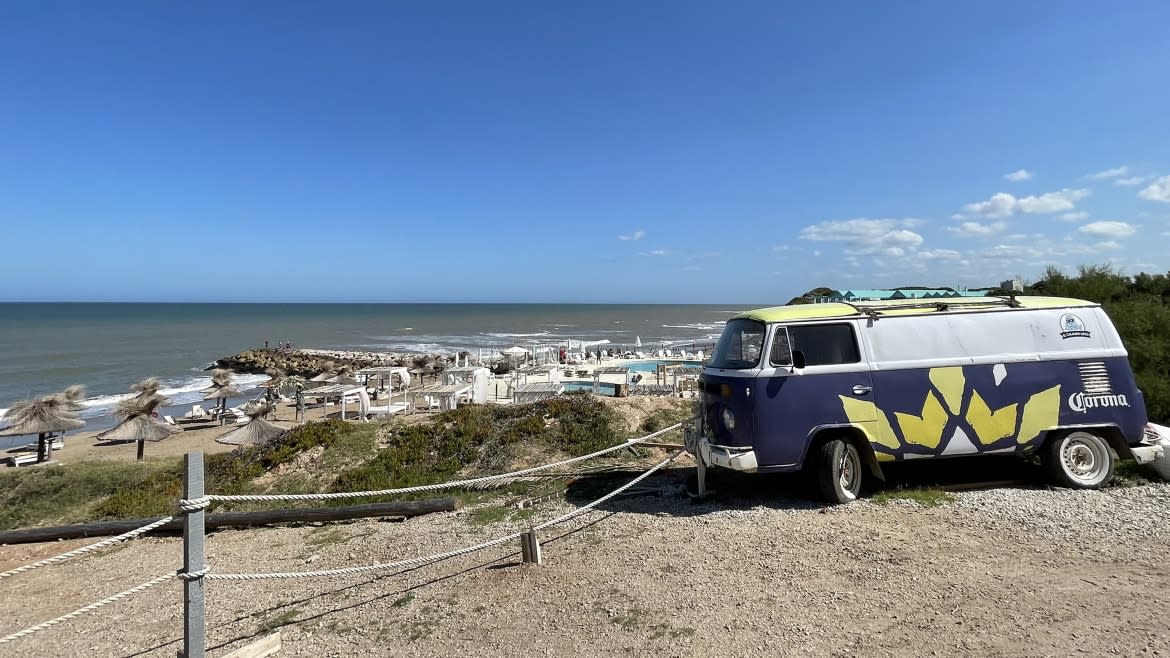
This is the latest in our series on underrated destinations, It's Still a Big World.
“Don’t go there. It explodes.”
Every time an Argentinian warned me that Mar del Plata, the coastal city five hours from Buenos Aires, explodes with people as soon as schools let out for summer in December, they made it seem like the carnage of cheap sunglasses, sea-lion souvenirs, and frozen daiquiri cups rained down on the entire Atlantic coast. When I asked if there really wasn’t a chiller beach town nearby, they told me, “You have dollars. Go to Uruguay.”
Except I once paid $10 for a cup of coffee in José Ignacio. So instead of returning to “the Hamptons of South America,” I booked a stone cottage in a grass field in El Marquesado, about half an hour south of Mar del Plata. All I knew about the place was that it was walking distance to a gay-friendly nude beach with a clifftop swimming pool and clothing-optional bar. As it turned out, that was one of the only things nearby. When my driver had to steer around an owl loitering in the dirt road to drop me off at my Airbnb, she informed me I was en la loma del orto (figuratively “in the middle of nowhere,” literally “on ass hill”). But a geodesic dome amidst the pampas grass made me suspect that something interesting was afoot here.
Later, my Airbnb host confirmed it. The thirtysomething with ripped jeans and frosted tips had dropped out of the police force to live a life of joda at “after beach” parties. As he drove me to a massive rave at Mute beach club, he told me that El Marquesado was one of the “growing communities” that make up Chapadmalal, which has recently become one of Argentina’s hottest summer destinations.
Until a few years ago, Chapadmalal, which spans the 12 miles of coast between Mar del Plata and the family-friendly resort town of Miramar, made news mostly when Argentina’s heads of state retreated to the presidential bungalow complex there. Occasionally, there were articles lamenting the decline of the adjacent hotel complex that the Evita Foundation had opened around the same time, in 1948, as a refuge for those of modest means. In the past few years, however, it has been popping up in far sexier headlines in Argentinian papers minting it “The Next José Ignacio” (2021) and “The New Youth Paradise” (2022). In a curious twist, not all of the stories are about hypergentrification. At the same time that Chapa becomes “The Most Desirable Destination on the Atlantic Coast” (2022), Evita’s hotels are being restored and reopened, ensuring that Argentina’s increasingly squeezed working class can still score a cheap choripán among the Buddha bowls.
Many of the articles about Chapa take the form of explainers: How did this place where cows and horses still graze in unfenced lots blow up into la playa mas “cool”? The transformation started pre-pandemic, but the oft-repeated story is that well-to-do Argentinians who found themselves barred from traveling to La Barra, Cabo Polonio, Florianópolis, and other haute-boho beach towns in Uruguay and Brazil began looking to their own coast for “surf and yoga.” They turned to Chapa, where chill types like Flavio Cianciarulo of legendary ska rockers Los Fabulosos Cadillacs had long been catching waves. When the borders reopened, foreign travel remained prohibitive thanks to a worsening economy and weakening peso—as in, 100 percent inflation. Meanwhile, Chapa was offering discerning Argentinians still more reasons to stay local. In 2022, Bai Bai, one of the local surf schools, upgraded its quaint hostel by adding a café with pergola seating and a coworking space overlooking the ocean. When I visited, the rock garden’s chill vibes were marred by a conspicuous Chevrolet logo, left over from a series of pop-up dinners the brand had sponsored.
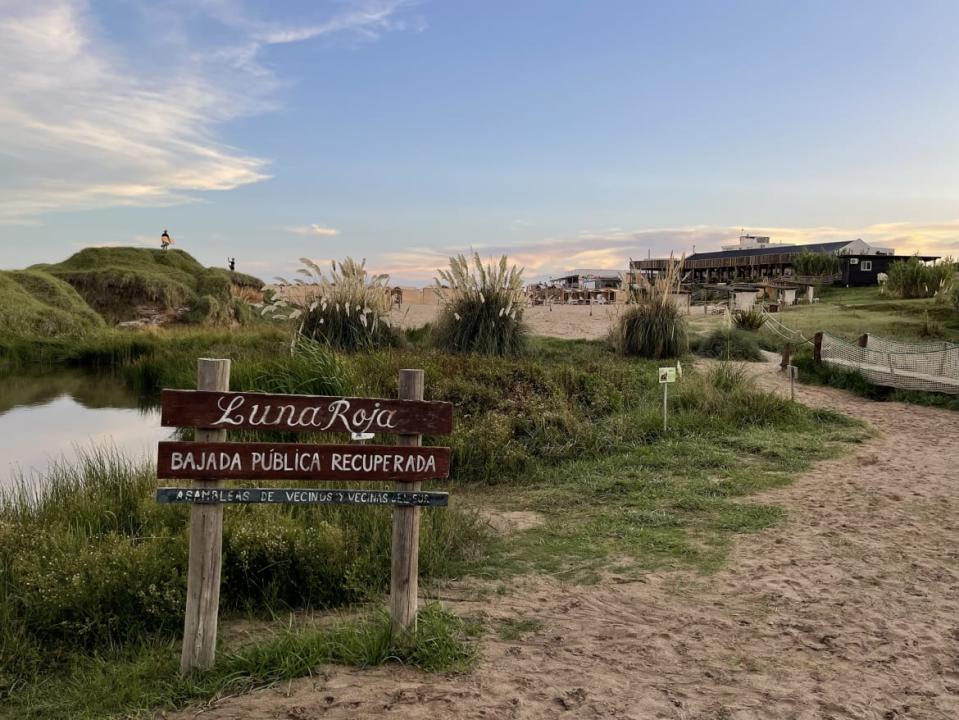
Playa Luna Roja.
Chapa is divided by Route 11, or just la ruta, the two-lane coastal highway where the indispensable Costa Azul bus line barrels past shrines to cowboy turned folk saint Gauchito Gil. On one side are the sparsely populated neighborhoods like El Marquesado— some downright dusty, others with fresh-cut lawns— where sleek modular houses are being erected amidst the long-standing casitas. On the coastal side of la ruta, meanwhile, are the balnearios, or beach clubs, where for decades families have flocked to take advantage of oceanside amenities like cabanas, swimming pools, restaurants, and tiki bars. Playa Luna Roja, which a few years ago became the trendiest of these balnearios, after its restaurant was revamped into the type of irresistible place that serves both mussels provencal and Baileys frozens— even has a skate ramp and an espresso shack. As with neighboring balnearios Siempre Verde, Casa Pampa Playa, and Cruz del Sur, there are fees to use the club’s amenities but the beaches are public by law.
If this all sounds a little too much like the tent cities that clog the sands of Mar del Plata— albeit with far fewer kids— rest assured there are also wild beaches where you might find yourself more or less alone with the circling hawks and the occasional beached penguin or sea lion. This is the beauty of Chapadmalal. Los Lobos beach, in the neighborhood of the same name, is reached by a winding path dynamited into the cliffs, and you have to grab hold of a short rope to descend the last few feet— not easy to do with a yerba mate thermos under your armpit. The beaches of the Santa Isabel and El Marquesado neighborhoods are tucked behind the highly Instagrammable ruins of balnearios that double as street-art canvases. Just down the road from Luna Roja, between two red-rock cliffs whose strata resemble the layers of an alfajor sandwich cookie, is the concrete foundation of a would-be balneario that sat fallow for some two decades until a local skateboarding school turned it into a skate bowl, Paradise DIY.
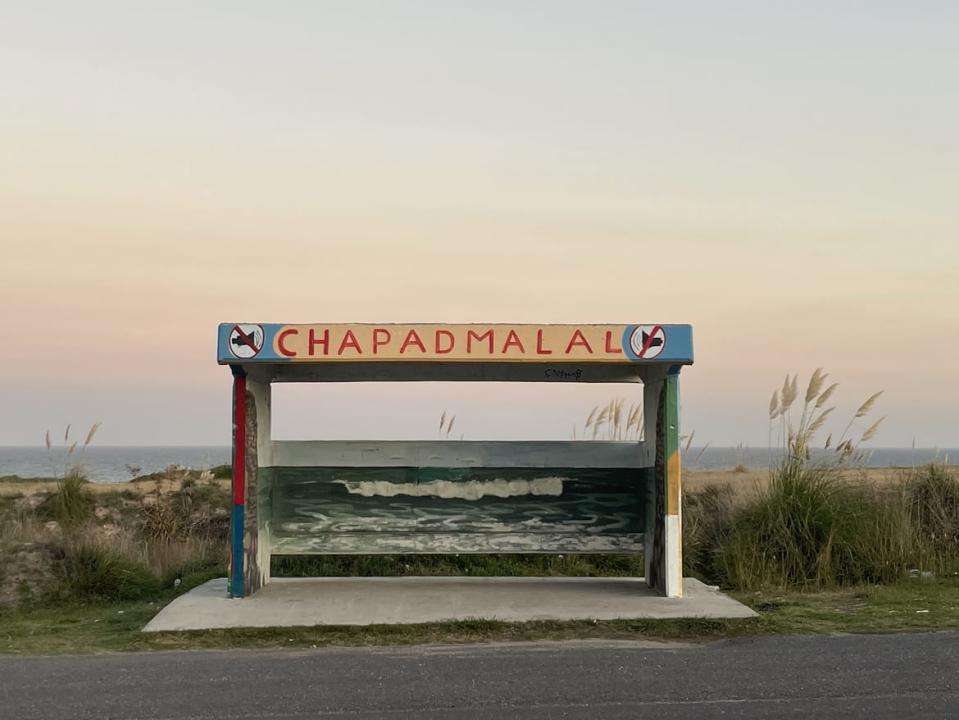
Bus stop in Chapadmalal.
When the sun sets over these monumental cliffs and the moon rises over the ocean’s horizon, beachgoers begin strolling over to Playa Chapadmalal, the neighborhood containing Chapa’s laid-back commercial center. Along the unpaved main drag, in the shadow of towering eucalyptus trees populated by green parrots, outdoor vendors hawk “aura protection” sprays and mandalas made from recycled CDs. Lately, bigger brands like Lightning Bolt have started selling clothing out of vintage trailers. Stroll around and you’ll find Birra & Skate, a homegrown bar started by a brewer and deck shaper where DJs squeeze in next to the skate ramp; Luva, a coffee shop serving turmeric lattes in a yard watched over by a local metalsmith’s sculptures; AFT Rancho, a surfer hostel with firepits clustered around an outdoor bar and wood-burning oven; and the anchor of the area, Las Cuevas, a plant-based restaurant with an inviting backyard where musicians perform. The endeavor started in 2016 when two local brothers began selling growlers of homebrew and this year evolved to include an outdoor pop-up kitchen, Proyecto Pescado, turning out seafood specials like ceviche made from local amberjack.
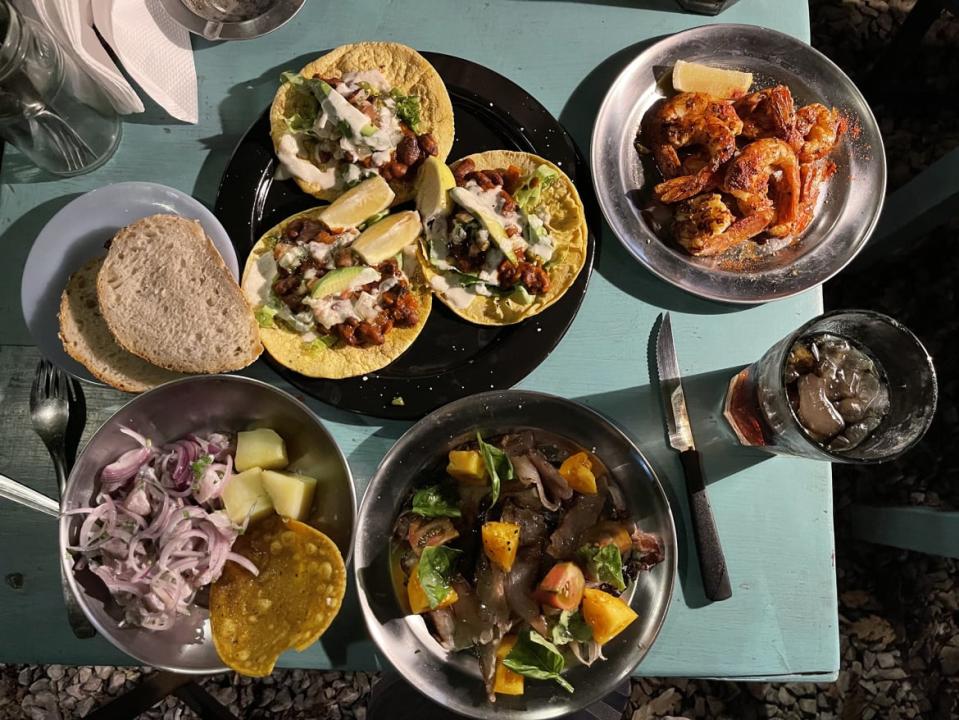
Dinner at Las Cuevas.
A few doors down from Las Cuevas, Alonso Chapadmalal Terrenos sells empty lots at increasingly elevated prices to these types of endeavors. (Their website currently lists around 60 of them, ranging from the equivalent of about US$7,500 in pesos to a straight US$130,000.) Gabriela Alonso Iriart, one of the firm’s brokers and a lifelong local, told me that even she couldn’t keep track of all the newcomers. “Things have grown so much lately that my friends will be like, ‘Che, did you see there’s a place that [does such-and-such]?’ And I’ll be like, ‘Oh! I didn’t know.’”
At La Hosteria Bar & Hostel, right next to Alonso Iriart’s office in Playa Chapadmalal, I met a couple of the creatives that she had told me are increasingly gravitating to Chapa. Danny Kacew, a 32-year-old Argentinian, and Curtis Ford, a 29-year-old Brit, told me they had met while living a hard-scrabble existence in Sheffield, England, and were in Chapa putting together an album with their band, Tempus Fugit. “We came here basically to heal ourselves of all these shitty chemicals we didn’t have in the past,” Danny said, beaming with satisfaction over the decision—or maybe from the malbec. “And I came to nature. We are from nature. The sound of our band comes from nature.”
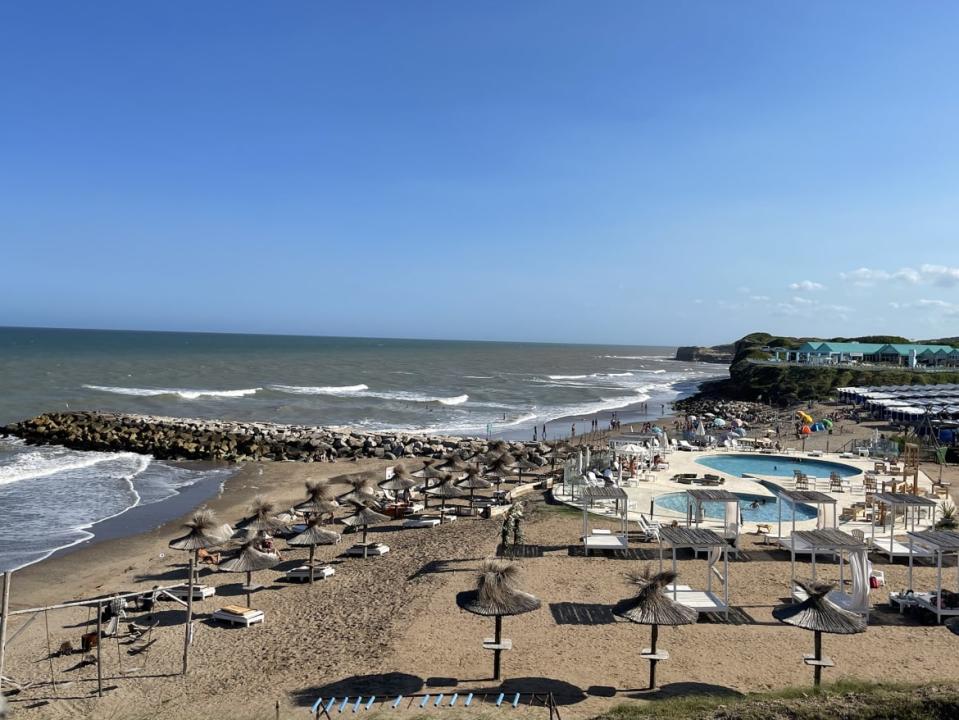
Casa Pampa Playa.
I learned what he meant when they invited me over to the one-bedroom apartment and makeshift studio they were sharing in Playa Chapadmalal, stumbling distance from La Hosteria. Like most of Chapa’s homes, it was warmed by a fireplace and the plumbing was dodgy. The place resembled a room in the Just Kids-era Chelsea Hotel, complete with a “magik suitcase” full of clothes they had glammed up, an array of spray-paint cans, and half-finished canvases. As I watched them belt out what sounded like an outtake from Ziggy Stardust, I noticed that Curtis’s drumsticks were actually twigs he had picked up off the ground. From nature, indeed.
Having found the place through a family friend, the Tempus Fugit boys were paying just $130 per month—but without a local hookup you’re more likely to find Airbnbs asking that per night. That’s an outlandish sum for the average Argentinian, which is why, in 2020, the federal government began to restore and remodel the Chapadmalal Tourism Unit, a 185-acre “social tourism” complex of nine hotels built at the start of the first Peron administration. The three-story buildings aimed to allow the working class to enjoy an area of Chapadmalal that had traditionally been reserved for upper-crust estancias such as Santa Isabel (now home to a bodega) and Marayuí (now a hotel and golf course). After the Peron era, government austerity and financial crises caused the hotels to fall into disrepair and as many as 20 years of abandonment. In 2021, however, five of the buildings reopened after intense refurbishment, with more to follow; this past season, rooms there could be rented for the equivalent of less than $4 per night.
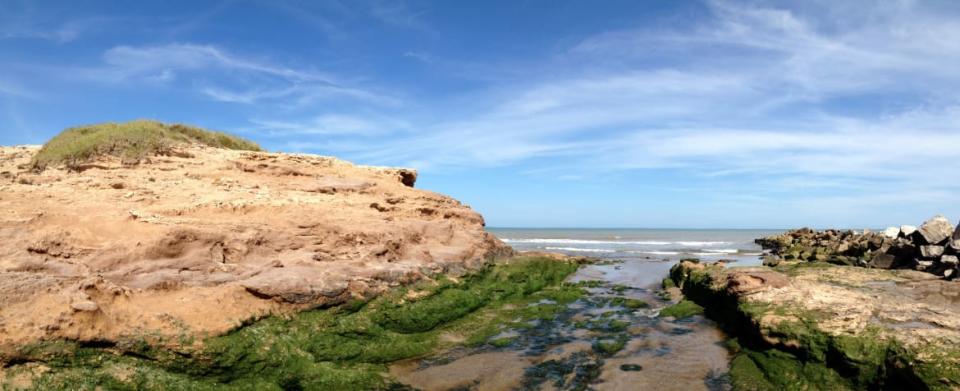
With their Spanish tile roofs and wood-paneled lobbies dotted with Mission-style furniture, the hotels of Colonia Chapadmalal, as this neighborhood just down the road from trendier Playa Chapadmalal is called, are decidedly of another era. The weekly programming displayed on easels consists of family-friendly activities like folk dancing and sand-castle building. The gift shops on the open-plan ground floors sell boxes of traditional alfajores and hand-painted yerba mate mugs. Proud Peronists can buy a T-shirt showing one of the Eva Peron Foundation buses that shuttled poor children to the hotels. The shirt says “CHAPA: Social Tourism Since 1948.” Compare that to the one over at the Ala Moana Surfshop & Café that reads “Barrels & Orgasms.”
Tucked into a corner of Hotel 5, next to a concession stand frying up milanesas, is the free-admission Eva Peron Museum—not to be confused with the famed one in Buenos Aires. Although this single room exhibits replicas of Evita’s ballgowns as well as a pair of metal rollerskates donated to children by her foundation, most of the artifacts consist of fixtures and furniture salvaged from the hotels—plus an old console stereo from the neighboring presidential bungalows. Blueprints and maps show how Hotel 3 was reserved for children and Hotel 6 was the domain of retirees.
Mariana Quiroga, an architect who directs public works projects for the federal government, has been leading the conversion of one of the SRO-style hotels where the rooms contained bunk beds for children. While her team is adding modern touches such as bathrooms in each unit, they’re meticulously preserving traditional elements such as the candlepin bowling alley.
When I asked her why not repurpose the bowling alley and theater, she told me they were part of the national heritage, and trendier amusements could be found elsewhere in Chapa and Mar del Plata. “These hotels allow people of modest means—maybe someone from Salta [in Argentina’s mountainous north], maybe someone who in 50 years has never gotten to know the ocean—to do something as simple as that: get to experience the ocean,” she said. “That spirit will be preserved so long as the state keeps regulating the hotels and the concessions. Because at one point there was talk of giving Hotel 1 to NH, Hotel 2 to another hotel chain. We feared that [private companies] would take over.”
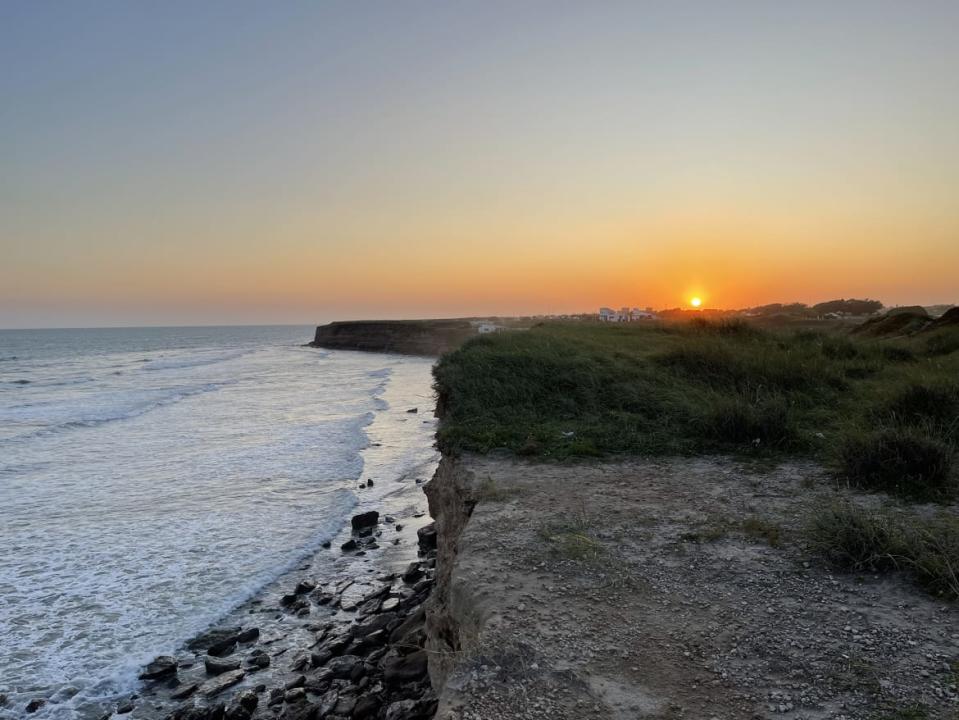
Sunset over Chapadmalal.
During a weekday in February, I sat on the rickety wooden deck of one of the hotel’s concession stands and drank a fernet and Coke that was about a third of the price and twice as strong as the one that had been measured out for me at the nearby Cruz del Sur balneario. It was the end of high season and there were only a handful of people on the exceptionally broad beach. It seemed to me that I had caught Chapadmalal at a sort of golden hour, or what a Uruguayan who had visited me there (isn’t it ironic?) called churro hour.
As I got up to head back into town, I noticed that the concession stand’s exterior had been painted over with a mural advertising a local surfwear brand, Camaron Brujo. A few feet away, workers were setting up a pop-up location of the Ala Moana surf-shop chain. Even here, the tide was turning.
Get the Daily Beast's biggest scoops and scandals delivered right to your inbox. Sign up now.
Stay informed and gain unlimited access to the Daily Beast's unmatched reporting. Subscribe now.

